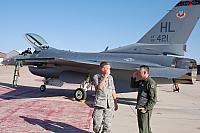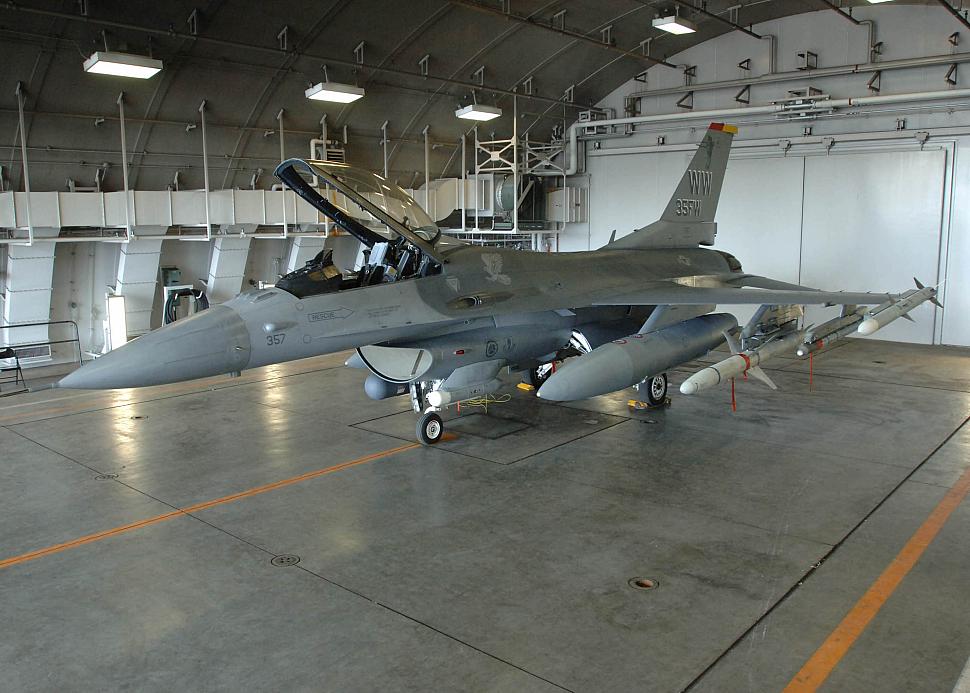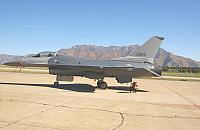Fighter Jet News
F-16 Fighting Falcon News
OO-ALC completes 500th F-16 CCIP modification
March 25, 2010 (by
CCIP Program Office) -
The Common Configuration Implementation Program, or CCIP (pronounced C-Sip) as it is commonly known, is the largest modification program ever undertaken on the Falcons. A CCIP rollout ceremony Friday, March 26, in the 309th Flight Test Building 233 will be held at 1 p.m. to mark the occasion.
All flight line personnel, 508th Aircraft Sustainment Wing members, 416th Supply Chain Management Squadron personnel and 309th Maintenance Group members are invited. Col. James Taylor, commander of the 162nd Fighter Wing based at the Arizona Air National Guard will be the pilot accepting the aircraft and flying it to his home base.
Speakers will include Col. Daniel Gordon, 508th Aircraft Sustainment Group commander, Irma Sippel, Lockheed Martin Aeronautics Program Management director, and Greg Hoffman, 537rd Aircraft Maintenance Squadron director.
The CCIP modification is relatively unique in that it was developed both as a series of operational improvements for combat effectiveness and as a way to make maintenance and logistics support more common between different versions of the F-16. The modification also resulted in F-16s having a high degree of commonality with the F-16s owned by five European NATO partners and many foreign military-operated F-16s worldwide.
From 2001 to 2006, the Ogden Air Logistics Center at Hill Air Force Base modified and delivered 254 Block 50/52 aircraft operated by the U.S. Air Force. The modifications took place in three phases and, as a result, 100 aircraft were modified twice during this timeframe. The initial 40 aircraft that were modified had only the Modular Mission Computer (MMC), a system of Color Multi-Function Displays and a Common Data Entry Electronics Unit installed. Along with these hardware modifications, the operating software on the aircraft was also upgraded to allow carriage of a targeting pod and a special bomb rack capable of communicating with new "smart" weapons. The modifications occurred from September 2001 to November 2002 and the aircraft were primarily operated by Shaw AFB, Calif., and McEntire Air National Guard Base, S.C.
The second group of 60 aircraft had these same systems installed, but added an advanced interrogator/transponder, or AIFF. The installations occurred from June 2002 to July 2003 and included aircraft from Mountain Home AFB, Idaho, Shaw and McEntire.
The last group had all four previous systems, plus the helmet-mounted cueing system, or JHMCS, and data link (MIDS) installed as a complete package. These installations occurred from March 2003 to June 2005 and included aircraft from Shaw, Spangdahlem Air Base, Germany, and Misawa Air Base, Japan. During this time, aircraft from the first two groups were re-inducted to have all remaining systems installed and those 100 aircraft were completed by May 2006. At that point, all Block 50/52 aircraft in the USAF inventory were CCIP capable.
In 2005, OO-ALC also began modifying the Block 40/42 fleet. Unlike the Block 50/52 modification plan, all Block 40/42 aircraft had the entire modification completed in a single visit. While the aircraft was undergoing the CCIP modification, the Falcon STAR (Structural Augmentation Roadmap) modification was also completed. Falcon STAR combines a series of structural improvements designed to greatly increase the service life of the aircraft. Combining these two large-scale modifications into one 144-day modification decreased total modification time by roughly 45 days, had the modifications been performed separately. This savings assured the owning units would have the aircraft available for flight operations as quickly as possible. Including the delivery of the final aircraft this month, 306 Block 40/42 aircraft from 12 different U.S. Air Force and Air National Guard bases were modified at OO-ALC.
All the systems mentioned provide a host of advantages both to the pilot and the maintainer. The MMC replaced three other on-board computers and provided much greater memory and throughput, significantly reduced the weight and volume, and is a much more reliable and easily maintained component. The color displays greatly improve pilot awareness by allowing the pilot to easily differentiate the various data on the display. The AIFF provides reliable identification of friend or foe, thereby enabling the employment of beyond-visual-range weapons, like the AIM-120 Advanced Medium Range Air-to-Air Missile, and dramatically reducing the potential for "friendly fire" incidents.
While those systems are all improvements on, or replacements for, existing systems, two of the systems installed during the modification offer completely new capabilities to the F-16. The Joint Helmet Mounted Cueing System is a display projected onto the pilot's helmet visor. The display includes both navigational and targeting data and gives the pilot the ability to acquire targets to the sides, above, and even behind the aircraft. The Aircraft Intercept Missile-9X heat-seeking missile works with the JHMCS allowing the pilot to fire upon other aircraft, in a dogfight situation, without the need to first point the front of the aircraft at the target. This provides a huge tactical advantage to the pilot and greatly increases the overall lethality of the F-16.
The Multi-function Information Distribution System, or MIDS, is a robust, highly integrated data link. Rather than simply relying on on-board sensors or information received from radio transmissions, the MIDS provides theater-wide situational awareness to a pilot that is light years ahead of previous capability. Without any input from the pilot, the MIDS communicates between aircraft, ground personnel, and Command and Control elements to ensure the widest possible dissemination of up-to-the-moment information. This enables pilots to determine the safest route to a target, prioritize multiple threats and take necessary evasive actions, and even allows aircraft to be re-routed during the mission if a higher priority target is discovered.
Before CCIP, Block 40/42 and Block 50/52 pilots traditionally flew different mission types. The Block 40/42 fleet flew with targeting pods and they were used in a precision bombing role called Destruction of Enemy Air Defenses, or DEAD. Block 50/52 aircraft traditionally flew with sensors that would detect enemy radars. The Suppression of Enemy Air Defenses, or SEAD, mission would commence when pilots would attack the radar site with the objective of crippling the enemy's capability to attack our aircraft from the ground. Targeting pods on Block 50/52 aircraft, and new sensor capability on Block 40/42 aircraft, have further increased the capabilities of the F-16. After CCIP, both blocks can fly both missions -- even at the same time. This is especially important to theater commanders who, instead of basing their tactical decisions on what Block of F-16 was currently available, can now direct any F-16 to do virtually any job.
As mentioned earlier, two key advantages of the modification are providing commonality for maintenance and logistics. Previously, the avionics systems on Block 40/42 aircraft were significantly different than Block 50/52 aircraft. This required two separate training curriculums for maintainers. Airmen who were qualified to work on one block required re-training before they could be assigned to work on a different block. Post CCIP aircraft are alike in almost every way, regardless of block. Avionics maintainers now attend a common school, negating the need for two separate training programs. They can also easily move from one block to another, thereby removing the need to re-train personnel each time they are re-assigned to a new base.
Logistically, there is no longer a need to provide two sets of spare parts. USAF supply personnel were required to maintain two different sets of replacement parts at forward operating locations to accommodate the variety of aircraft that may be deployed there. Now the spares are common between blocks, greatly reducing the storage requirements at these locations. Costs associated with the off-aircraft repair of components from multiple systems are significantly reduced since only one system needs to be maintained instead of the previous two.
Incorporating numerous improvements and adding incredible new capabilities, CCIP was easily the most ambitious, largest scale modification ever made to the F-16. Thanks to the efforts of the hundreds of dedicated men and women at Ogden Air Logistics Center at Hill AFB, it is also one of the most successful.
Speakers will include Col. Daniel Gordon, 508th Aircraft Sustainment Group commander, Irma Sippel, Lockheed Martin Aeronautics Program Management director, and Greg Hoffman, 537rd Aircraft Maintenance Squadron director.
The CCIP modification is relatively unique in that it was developed both as a series of operational improvements for combat effectiveness and as a way to make maintenance and logistics support more common between different versions of the F-16. The modification also resulted in F-16s having a high degree of commonality with the F-16s owned by five European NATO partners and many foreign military-operated F-16s worldwide.
From 2001 to 2006, the Ogden Air Logistics Center at Hill Air Force Base modified and delivered 254 Block 50/52 aircraft operated by the U.S. Air Force. The modifications took place in three phases and, as a result, 100 aircraft were modified twice during this timeframe. The initial 40 aircraft that were modified had only the Modular Mission Computer (MMC), a system of Color Multi-Function Displays and a Common Data Entry Electronics Unit installed. Along with these hardware modifications, the operating software on the aircraft was also upgraded to allow carriage of a targeting pod and a special bomb rack capable of communicating with new "smart" weapons. The modifications occurred from September 2001 to November 2002 and the aircraft were primarily operated by Shaw AFB, Calif., and McEntire Air National Guard Base, S.C.
The second group of 60 aircraft had these same systems installed, but added an advanced interrogator/transponder, or AIFF. The installations occurred from June 2002 to July 2003 and included aircraft from Mountain Home AFB, Idaho, Shaw and McEntire.
The last group had all four previous systems, plus the helmet-mounted cueing system, or JHMCS, and data link (MIDS) installed as a complete package. These installations occurred from March 2003 to June 2005 and included aircraft from Shaw, Spangdahlem Air Base, Germany, and Misawa Air Base, Japan. During this time, aircraft from the first two groups were re-inducted to have all remaining systems installed and those 100 aircraft were completed by May 2006. At that point, all Block 50/52 aircraft in the USAF inventory were CCIP capable.
In 2005, OO-ALC also began modifying the Block 40/42 fleet. Unlike the Block 50/52 modification plan, all Block 40/42 aircraft had the entire modification completed in a single visit. While the aircraft was undergoing the CCIP modification, the Falcon STAR (Structural Augmentation Roadmap) modification was also completed. Falcon STAR combines a series of structural improvements designed to greatly increase the service life of the aircraft. Combining these two large-scale modifications into one 144-day modification decreased total modification time by roughly 45 days, had the modifications been performed separately. This savings assured the owning units would have the aircraft available for flight operations as quickly as possible. Including the delivery of the final aircraft this month, 306 Block 40/42 aircraft from 12 different U.S. Air Force and Air National Guard bases were modified at OO-ALC.
All the systems mentioned provide a host of advantages both to the pilot and the maintainer. The MMC replaced three other on-board computers and provided much greater memory and throughput, significantly reduced the weight and volume, and is a much more reliable and easily maintained component. The color displays greatly improve pilot awareness by allowing the pilot to easily differentiate the various data on the display. The AIFF provides reliable identification of friend or foe, thereby enabling the employment of beyond-visual-range weapons, like the AIM-120 Advanced Medium Range Air-to-Air Missile, and dramatically reducing the potential for "friendly fire" incidents.
While those systems are all improvements on, or replacements for, existing systems, two of the systems installed during the modification offer completely new capabilities to the F-16. The Joint Helmet Mounted Cueing System is a display projected onto the pilot's helmet visor. The display includes both navigational and targeting data and gives the pilot the ability to acquire targets to the sides, above, and even behind the aircraft. The Aircraft Intercept Missile-9X heat-seeking missile works with the JHMCS allowing the pilot to fire upon other aircraft, in a dogfight situation, without the need to first point the front of the aircraft at the target. This provides a huge tactical advantage to the pilot and greatly increases the overall lethality of the F-16.
The Multi-function Information Distribution System, or MIDS, is a robust, highly integrated data link. Rather than simply relying on on-board sensors or information received from radio transmissions, the MIDS provides theater-wide situational awareness to a pilot that is light years ahead of previous capability. Without any input from the pilot, the MIDS communicates between aircraft, ground personnel, and Command and Control elements to ensure the widest possible dissemination of up-to-the-moment information. This enables pilots to determine the safest route to a target, prioritize multiple threats and take necessary evasive actions, and even allows aircraft to be re-routed during the mission if a higher priority target is discovered.
Before CCIP, Block 40/42 and Block 50/52 pilots traditionally flew different mission types. The Block 40/42 fleet flew with targeting pods and they were used in a precision bombing role called Destruction of Enemy Air Defenses, or DEAD. Block 50/52 aircraft traditionally flew with sensors that would detect enemy radars. The Suppression of Enemy Air Defenses, or SEAD, mission would commence when pilots would attack the radar site with the objective of crippling the enemy's capability to attack our aircraft from the ground. Targeting pods on Block 50/52 aircraft, and new sensor capability on Block 40/42 aircraft, have further increased the capabilities of the F-16. After CCIP, both blocks can fly both missions -- even at the same time. This is especially important to theater commanders who, instead of basing their tactical decisions on what Block of F-16 was currently available, can now direct any F-16 to do virtually any job.
As mentioned earlier, two key advantages of the modification are providing commonality for maintenance and logistics. Previously, the avionics systems on Block 40/42 aircraft were significantly different than Block 50/52 aircraft. This required two separate training curriculums for maintainers. Airmen who were qualified to work on one block required re-training before they could be assigned to work on a different block. Post CCIP aircraft are alike in almost every way, regardless of block. Avionics maintainers now attend a common school, negating the need for two separate training programs. They can also easily move from one block to another, thereby removing the need to re-train personnel each time they are re-assigned to a new base.
Logistically, there is no longer a need to provide two sets of spare parts. USAF supply personnel were required to maintain two different sets of replacement parts at forward operating locations to accommodate the variety of aircraft that may be deployed there. Now the spares are common between blocks, greatly reducing the storage requirements at these locations. Costs associated with the off-aircraft repair of components from multiple systems are significantly reduced since only one system needs to be maintained instead of the previous two.
Incorporating numerous improvements and adding incredible new capabilities, CCIP was easily the most ambitious, largest scale modification ever made to the F-16. Thanks to the efforts of the hundreds of dedicated men and women at Ogden Air Logistics Center at Hill AFB, it is also one of the most successful.
Republished with kind permission of Hilltop Times.
Additional images:


The final 388th FW Block 40, #88-0421 from 421st FS to undergo CCIP upgrades is handed over to Col. Scott Dennis, 388th FW commander, in a ceremony on April 21st, 2008. Beginning in November 2005, depot workers from the 309th Maintenance Wing, led by Brig. Gen. Art Cameron, invested over 5,500 maintenance hours into each of 388th FW's 72 aircraft. CCIP brings upgraded avionics and communications systems to pilots in combat. Hill's 4th FS was the first to fly CCIP F-16s in combat in August of 2007. [USAF photo by Alex Lloyd]
Related articles:
Forum discussion:
Tags
- Luke receives final 2 CCIP F-16s (2008-11-14)
- HAI delivers 1st F-16 to USAF after CCIP upgrade (2008-03-20)
- 388th FW flies first combat ready F-16 Block 40 CCIP aircraft (2006-05-03)
- Largest ever F-16 modernization program enhances aircraft (2006-03-17)
- First F-16 CCIP delivered (2002-01-28)
- F-16 Fighting Falcon news archive
Forum discussion:
- Start a discussion about this article in the F-16.net forum.
Tags


